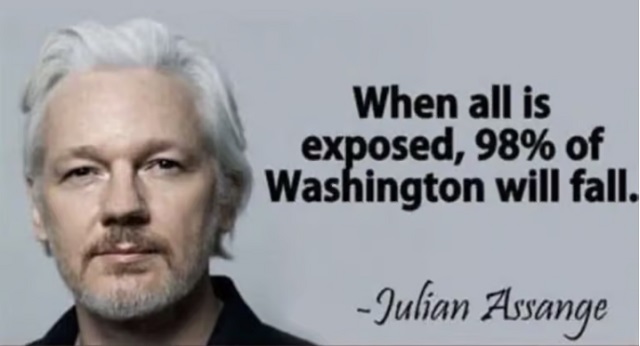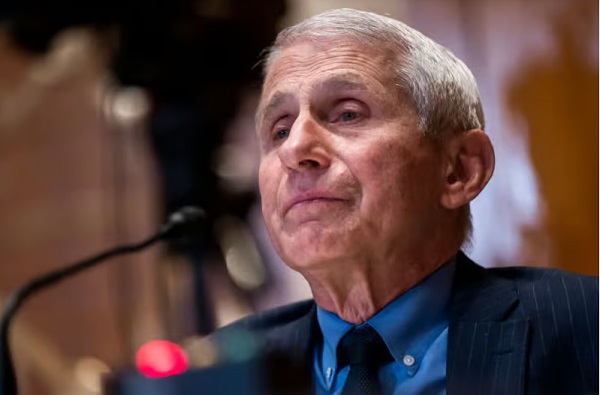Brownstone Institute
Assange and the Whistleblowers That Could’ve Been

From the Brownstone Institute
By
“‘Can’t we just drone this guy?’ Clinton openly inquired, offering a simple remedy to silence Assange and smother WikiLeaks via a planned military drone strike, according to State Department Sources…”
In the last four years of our Orwellian New Abnormal, the following thoughts occurred to me countless times:
What the world desperately needs is far more brave whistleblowers. What we need is an active and robust WikiLeaks…or far more organizations that perform the vital work of WikiLeaks.
The reasons this has not occurred are, of course, obvious.
The main reason is that the people who could disclose important information about government or Deep State crimes are simply terrified to do this.
They are afraid to do this because they, quite correctly, know they’d suffer deeply unpleasant consequences if they did disclose “inconvenient truths” that expose how corrupt the world’s most important organizations have now become.
Another reason: Organizations that might actually publish the claims of important whistleblowers, largely, do not exist. The entrepreneurs who might create and try to run these organizations have clearly noted the undeniable message the Establishment sent to Julian Assange and WikiLeaks.
That message? If you do publish documents or testimony that embarrasses or threatens us, THIS is what will happen to you.
Truth Bombs That Never Detonated
It’s true WikiLeaks continued to exist while its founder was imprisoned on bogus charges. However, the significant work product of WikiLeaks effectively disappeared while Assange was “dealt with” by the State.
With a few lower-profile exceptions, no organizations assumed the risks of performing the dangerous work of WikiLeaks.
Because of this, many narrative-changing “truth bombs” never detonated…at a time when the world needed Real Truth more than ever.
While Assange is no longer in a British prison—and won’t have to serve the rest of his life in an American Maximum Security prison—the Intimidation State largely achieved its primary goal of taking proactive measures to ensure no one would expose their crimes.
Even today, 100 shocking scandals—genuine “crimes against humanity”—could be definitively exposed if more whistleblowers came forward…and if the information provided by these whistleblowers was disseminated to the mass public.
These Revelations That Never Happened are all “unknown unknowables.” The public will never know things it might otherwise have learned about our society’s real rulers.
It is surely not a coincidence that in the 12 years Assange was either in prison or seeking refuge in an embassy, the Censorship Industrial Complex transitioned from non-existent to the largest growth industry in the bureaucratic state.
Whether it’s NewsGuard, Media Matters, or the Stanford “Virality Project,” scores of anti-disinformation organizations now exist to shut down or deamplify dissenting voices. These well-funded and coordinated organizations eagerly do the bidding of governments that fear and despise “free speech” and a “search for the truth.”
If Julian Assange was trying to warn the world that Big Brother was going to get much bigger (and he was sending this warning), he was clearly proven right.
A Few Details of the Assange Saga Should Not Be Forgotten
Before writing this story, I refreshed my memory regarding the details of the Assange saga.
I was reminded that Mike Pompeo, the former US Secretary of State and CIA director, once seriously considered a plot to assassinate Assange.
So did Hillary Clinton when she was Secretary of State.
According to this Substack review, “Hillary Clinton, one of the worst warmongers in the history of America, proposed to use Barrack (sic) Hussein Obama’s favorite illicit assassination method for Assange.
“‘Can’t we just drone this guy?’ Clinton openly inquired, offering a simple remedy to silence Assange and smother WikiLeaks via a planned military drone strike, according to State Department Sources…”
Hillary was no fan of Assange because it was WikiLeaks that revealed her sycophants conspired with the Democratic Party (via Clintonian “dirty tricks”) to ensure her nomination.
WikiLeaks went a Leak Too Far when the organization published videos showing that US Army helicopters killed many innocent Iraqi civilians—including several International journalists—in one of our nation’s wars to “protect democracy.”
The organization also published reports of torture and mistreatment of prisoners and documented revelations showing how the massive US Intelligence Community was spying on, potentially, millions of citizens.
I Get Why Most Americans Don’t Want to Think about Assange
I think I understand why many Americans view Assange as either a villain or simply prefer to not think about what’s been done to this man.
Every WikiLeak revelation supports the conclusion that America might not be the force for “freedom” most Americans grew up thinking our nation was.
For most people, the thought that “Maybe we aren’t the Good Guys after all” is intolerable medicine.
Still, the national consensus should have been that it was the country’s leaders—and government entities—who are acting as tyrants. That is, it wasn’t everyday Janes and Joes who were mimicking North Korea; it was our government and all the organizations that wanted to stay on the safer side of this 900-pound gorilla.
The message that’s yet to resonate with enough people is that “We the People” could easily get rid of these Bad Actors who are trying to rebrand the “American Way.”
Portrayed as Enemy No. 1 by our government, Julian Assange was simply trying to provide citizens the knowledge we needed to self-correct and purge these actors before they became too powerful to stop.
Let Us Not Forget Who Was Fine with Assange’s Imprisonment
As some of us celebrate Assange’s release, we should also reflect on the powerful institutions and influential citizens who never rallied to his defense.
Surreally, chief among these groups is the vast majority of members of the mainstream media “watchdog” press.
The Washington Post tells us that “Democracy dies in darkness” and yet the Post was more than content with Julian Assange languishing in a dark prison cell for the rest of his life. That is, the Post never used its considerable editorial influence to free the man who had shed the most light on the true nature of our leadership organizations.
Ninety-nine point-nine percent of the country’s activist celebrities were conspicuously silent about the deplorable treatment of Julian Assange (or Ed Snowden or Chelsey Manning or any person who disagreed with Anthony Fauci).
The best-known defenders of Julian Assange were the conceptual leader of Pink Floyd and an actress who once starred in Baywatch.
One has to ask where Bruce Springsteen, Bob Dylan, Bono, Jane Fonda, and Robert DeNiro were when Assange was in a British prison? They certainly weren’t outside his prison cell protesting.
Assange Has Not Received ‘justice’
Some are now saying that “justice” has been served for Assange. As Caitlin Johnstone reminds us, Assange hasn’t gotten any “justice.”
“So while Assange may be free, we cannot rightly say that justice has been done.
“Justice would look like Assange being granted a full and unconditional pardon and receiving millions of dollars in compensation from the US government for the torment they put him through by his imprisonment in Belmarsh beginning in 2019, his de facto imprisonment in the Ecuadorian embassy beginning in 2012, and his jailing and house arrest beginning in 2010.
“Justice would look like the US making concrete legal and policy changes guaranteeing that Washington could never again use its globe-spanning power and influence to destroy the life of a foreign journalist for reporting inconvenient facts about it, and issuing a formal apology to Julian Assange and his family.
“Justice would look like the arrest and prosecution of the people whose war crimes Assange exposed, and the arrest and prosecution of everyone who helped ruin his life for exposing those crimes. This would include a whole host of government operatives and officials across numerous countries, and multiple US presidents …”
On the occasion of last year’s World Freedom Day, “President” Joe Biden said, “Today—and every day—we must all stand with journalists around the world. We must all speak out against those who wish to silence them.”
Does anyone remember Joe Biden speaking out—even one time—against those who “silenced” Julian Assange?
And, for the record, who silenced him?
Republished from the author’s Substack
Brownstone Institute
FDA Exposed: Hundreds of Drugs Approved without Proof They Work

From the Brownstone Institute
By
The US Food and Drug Administration (FDA) has approved hundreds of drugs without proof that they work—and in some cases, despite evidence that they cause harm.
That’s the finding of a blistering two-year investigation by medical journalists Jeanne Lenzer and Shannon Brownlee, published by The Lever.
Reviewing more than 400 drug approvals between 2013 and 2022, the authors found the agency repeatedly ignored its own scientific standards.
One expert put it bluntly—the FDA’s threshold for evidence “can’t go any lower because it’s already in the dirt.”
A System Built on Weak Evidence
The findings were damning—73% of drugs approved by the FDA during the study period failed to meet all four basic criteria for demonstrating “substantial evidence” of effectiveness.
Those four criteria—presence of a control group, replication in two well-conducted trials, blinding of participants and investigators, and the use of clinical endpoints like symptom relief or extended survival—are supposed to be the bedrock of drug evaluation.
Yet only 28% of drugs met all four criteria—40 drugs met none.
These aren’t obscure technicalities—they are the most basic safeguards to protect patients from ineffective or dangerous treatments.
But under political and industry pressure, the FDA has increasingly abandoned them in favour of speed and so-called “regulatory flexibility.”
Since the early 1990s, the agency has relied heavily on expedited pathways that fast-track drugs to market.
In theory, this balances urgency with scientific rigour. In practice, it has flipped the process. Companies can now get drugs approved before proving that they work, with the promise of follow-up trials later.
But, as Lenzer and Brownlee revealed, “Nearly half of the required follow-up studies are never completed—and those that are often fail to show the drugs work, even while they remain on the market.”
“This represents a seismic shift in FDA regulation that has been quietly accomplished with virtually no awareness by doctors or the public,” they added.
More than half the approvals examined relied on preliminary data—not solid evidence that patients lived longer, felt better, or functioned more effectively.
And even when follow-up studies are conducted, many rely on the same flawed surrogate measures rather than hard clinical outcomes.
The result: a regulatory system where the FDA no longer acts as a gatekeeper—but as a passive observer.
Cancer Drugs: High Stakes, Low Standards
Nowhere is this failure more visible than in oncology.
Only 3 out of 123 cancer drugs approved between 2013 and 2022 met all four of the FDA’s basic scientific standards.
Most—81%—were approved based on surrogate endpoints like tumour shrinkage, without any evidence that they improved survival or quality of life.
Take Copiktra, for example—a drug approved in 2018 for blood cancers. The FDA gave it the green light based on improved “progression-free survival,” a measure of how long a tumour stays stable.
But a review of post-marketing data showed that patients taking Copiktra died 11 months earlier than those on a comparator drug.
It took six years after those studies showed the drug reduced patients’ survival for the FDA to warn the public that Copiktra should not be used as a first- or second-line treatment for certain types of leukaemia and lymphoma, citing “an increased risk of treatment-related mortality.”
Elmiron: Ineffective, Dangerous—And Still on the Market
Another striking case is Elmiron, approved in 1996 for interstitial cystitis—a painful bladder condition.
The FDA authorized it based on “close to zero data,” on the condition that the company conduct a follow-up study to determine whether it actually worked.
That study wasn’t completed for 18 years—and when it was, it showed Elmiron was no better than placebo.
In the meantime, hundreds of patients suffered vision loss or blindness. Others were hospitalized with colitis. Some died.
Yet Elmiron is still on the market today. Doctors continue to prescribe it.
“Hundreds of thousands of patients have been exposed to the drug, and the American Urological Association lists it as the only FDA-approved medication for interstitial cystitis,” Lenzer and Brownlee reported.
“Dangling Approvals” and Regulatory Paralysis
The FDA even has a term—”dangling approvals”—for drugs that remain on the market despite failed or missing follow-up trials.
One notorious case is Avastin, approved in 2008 for metastatic breast cancer.
It was fast-tracked, again, based on ‘progression-free survival.’ But after five clinical trials showed no improvement in overall survival—and raised serious safety concerns—the FDA moved to revoke its approval for metastatic breast cancer.
The backlash was intense.
Drug companies and patient advocacy groups launched a campaign to keep Avastin on the market. FDA staff received violent threats. Police were posted outside the agency’s building.
The fallout was so severe that for more than two decades afterwards, the FDA did not initiate another involuntary drug withdrawal in the face of industry opposition.
Billions Wasted, Thousands Harmed
Between 2018 and 2021, US taxpayers—through Medicare and Medicaid—paid $18 billion for drugs approved under the condition that follow-up studies would be conducted. Many never were.
The cost in lives is even higher.
A 2015 study found that 86% of cancer drugs approved between 2008 and 2012 based on surrogate outcomes showed no evidence that they helped patients live longer.
An estimated 128,000 Americans die each year from the effects of properly prescribed medications—excluding opioid overdoses. That’s more than all deaths from illegal drugs combined.
A 2024 analysis by Danish physician Peter Gøtzsche found that adverse effects from prescription medicines now rank among the top three causes of death globally.
Doctors Misled by the Drug Labels
Despite the scale of the problem, most patients—and most doctors—have no idea.
A 2016 survey published in JAMA asked practising physicians a simple question—what does FDA approval actually mean?
Only 6% got it right.
The rest assumed that it meant the drug had shown clear, clinically meaningful benefits—such as helping patients live longer or feel better—and that the data was statistically sound.
But the FDA requires none of that.
Drugs can be approved based on a single small study, a surrogate endpoint, or marginal statistical findings. Labels are often based on limited data, yet many doctors take them at face value.
Harvard researcher Aaron Kesselheim, who led the survey, said the results were “disappointing, but not entirely surprising,” noting that few doctors are taught about how the FDA’s regulatory process actually works.
Instead, physicians often rely on labels, marketing, or assumptions—believing that if the FDA has authorized a drug, it must be both safe and effective.
But as The Lever investigation shows, that is not a safe assumption.
And without that knowledge, even well-meaning physicians may prescribe drugs that do little good—and cause real harm.
Who Is the FDA Working for?
In interviews with more than 100 experts, patients, and former regulators, Lenzer and Brownlee found widespread concern that the FDA has lost its way.
Many pointed to the agency’s dependence on industry money. A BMJ investigation in 2022 found that user fees now fund two-thirds of the FDA’s drug review budget—raising serious questions about independence.

Yale physician and regulatory expert Reshma Ramachandran said the system is in urgent need of reform.
“We need an agency that’s independent from the industry it regulates and that uses high-quality science to assess the safety and efficacy of new drugs,” she told The Lever. “Without that, we might as well go back to the days of snake oil and patent medicines.”
For now, patients remain unwitting participants in a vast, unspoken experiment—taking drugs that may never have been properly tested, trusting a regulator that too often fails to protect them.
And as Lenzer and Brownlee conclude, that trust is increasingly misplaced.
- Investigative report by Jeanne Lenzer and Shannon Brownlee at The Lever [link]
- Searchable public drug approval database [link]
- See my talk: Failure of Drug Regulation: Declining standards and institutional corruption
Republished from the author’s Substack
Brownstone Institute
Anthony Fauci Gets Demolished by White House in New Covid Update

From the Brownstone Institute
By
Anthony Fauci must be furious.
He spent years proudly being the public face of the country’s response to the Covid-19 pandemic. He did, however, flip-flop on almost every major issue, seamlessly managing to shift his guidance based on current political whims and an enormous desire to coerce behavior.
Nowhere was this more obvious than his dictates on masks. If you recall, in February 2020, Fauci infamously stated on 60 Minutes that masks didn’t work. That they didn’t provide the protection people thought they did, there were gaps in the fit, and wearing masks could actually make things worse by encouraging wearers to touch their face.
Just a few months later, he did a 180, then backtracked by making up a post-hoc justification for his initial remarks. Laughably, Fauci said that he recommended against masks to protect supply for healthcare workers, as if hospitals would ever buy cloth masks on Amazon like the general public.
Later in interviews, he guaranteed that cities or states that listened to his advice would fare better than those that didn’t. Masks would limit Covid transmission so effectively, he believed, that it would be immediately obvious which states had mandates and which didn’t. It was obvious, but not in the way he expected.

And now, finally, after years of being proven wrong, the White House has officially and thoroughly rebuked Fauci in every conceivable way.
White House Covid Page Points Out Fauci’s Duplicitous Guidance
A new White House official page points out, in detail, exactly where Fauci and the public health expert class went wrong on Covid.
It starts by laying out the case for the lab-leak origin of the coronavirus, with explanations of how Fauci and his partners misled the public by obscuring information and evidence. How they used the “FOIA lady” to hide emails, used private communications to avoid scrutiny, and downplayed the conduct of EcoHealth Alliance because they helped fund it.
They roast the World Health Organization for caving to China and attempting to broaden its powers in the aftermath of “abject failure.”
“The WHO’s response to the COVID-19 pandemic was an abject failure because it caved to pressure from the Chinese Communist Party and placed China’s political interests ahead of its international duties. Further, the WHO’s newest effort to solve the problems exacerbated by the COVID-19 pandemic — via a “Pandemic Treaty” — may harm the United States,” the site reads.
Social distancing is criticized, correctly pointing out that Fauci testified that there was no scientific data or evidence to support their specific recommendations.
“The ‘6 feet apart’ social distancing recommendation — which shut down schools and small business across the country — was arbitrary and not based on science. During closed door testimony, Dr. Fauci testified that the guidance ‘sort of just appeared.’”
There’s another section demolishing the extended lockdowns that came into effect in blue states like California, Illinois, and New York. Even the initial lockdown, the “15 Days to Slow the Spread,” was a poorly reasoned policy that had no chance of working; extended closures were immensely harmful with no demonstrable benefit.
“Prolonged lockdowns caused immeasurable harm to not only the American economy, but also to the mental and physical health of Americans, with a particularly negative effect on younger citizens. Rather than prioritizing the protection of the most vulnerable populations, federal and state government policies forced millions of Americans to forgo crucial elements of a healthy and financially sound life,” it says.
Then there’s the good stuff: mask mandates. While there’s plenty more detail that could be added, it’s immensely rewarding to see, finally, the truth on an official White House website. Masks don’t work. There’s no evidence supporting mandates, and public health, especially Fauci, flip-flopped without supporting data.
“There was no conclusive evidence that masks effectively protected Americans from COVID-19. Public health officials flipped-flopped on the efficacy of masks without providing Americans scientific data — causing a massive uptick in public distrust.”
This is inarguably true. There were no new studies or data justifying the flip-flop, just wishful thinking and guessing based on results in Asia. It was an inexcusable, world-changing policy that had no basis in evidence, but was treated as equivalent to gospel truth by a willing media and left-wing politicians.
Over time, the CDC and Fauci relied on ridiculous “studies” that were quickly debunked, anecdotes, and ever-shifting goal posts. Wear one cloth mask turned to wear a surgical mask. That turned into “wear two masks,” then wear an N95, then wear two N95s.
All the while ignoring that jurisdictions that tried “high-quality” mask mandates also failed in spectacular fashion.

And that the only high-quality evidence review on masking confirmed no masks worked, even N95s, to prevent Covid transmission, as well as hearing that the CDC knew masks didn’t work anyway.
The website ends with a complete and thorough rebuke of the public health establishment and the Biden administration’s disastrous efforts to censor those who disagreed.
“Public health officials often mislead the American people through conflicting messaging, knee-jerk reactions, and a lack of transparency. Most egregiously, the federal government demonized alternative treatments and disfavored narratives, such as the lab-leak theory, in a shameful effort to coerce and control the American people’s health decisions.
When those efforts failed, the Biden Administration resorted to ‘outright censorship—coercing and colluding with the world’s largest social media companies to censor all COVID-19-related dissent.’”
About time these truths are acknowledged in a public, authoritative manner. Masks don’t work. Lockdowns don’t work. Fauci lied and helped cover up damning evidence.
If only this website had been available years ago.
Though, of course, knowing the media’s political beliefs, they’d have ignored it then, too.
Republished from the author’s Substack
-

 Crime2 days ago
Crime2 days ago“This is a total fucking disaster”
-

 Fraser Institute1 day ago
Fraser Institute1 day agoBefore Trudeau average annual immigration was 617,800. Under Trudeau number skyrocketted to 1.4 million annually
-

 International2 days ago
International2 days agoChicago suburb purchases childhood home of Pope Leo XIV
-

 MAiD2 days ago
MAiD2 days agoCanada’s euthanasia regime is already killing the disabled. It’s about to get worse
-

 Daily Caller2 days ago
Daily Caller2 days agoBlackouts Coming If America Continues With Biden-Era Green Frenzy, Trump Admin Warns
-

 Daily Caller2 days ago
Daily Caller2 days ago‘I Know How These People Operate’: Fmr CIA Officer Calls BS On FBI’s New Epstein Intel
-

 Red Deer1 day ago
Red Deer1 day agoJoin SPARC in spreading kindness by July 14th
-

 Business1 day ago
Business1 day agoPrime minister can make good on campaign promise by reforming Canada Health Act








